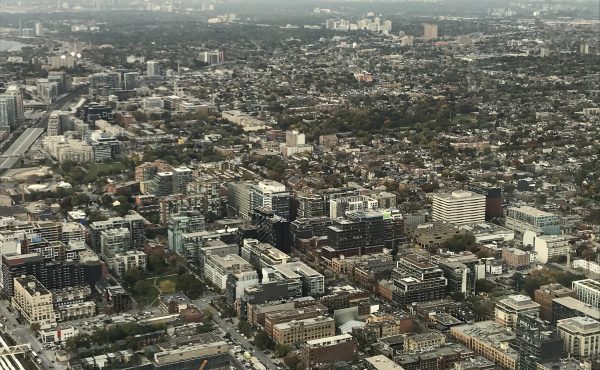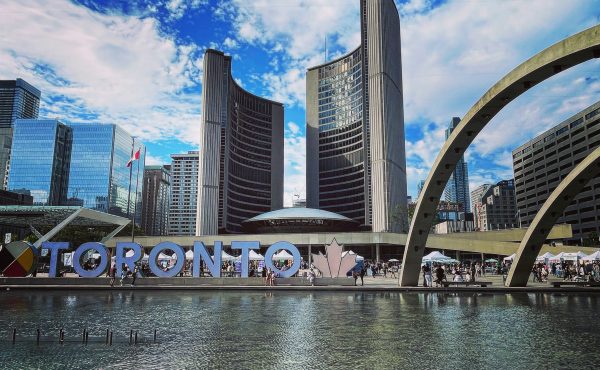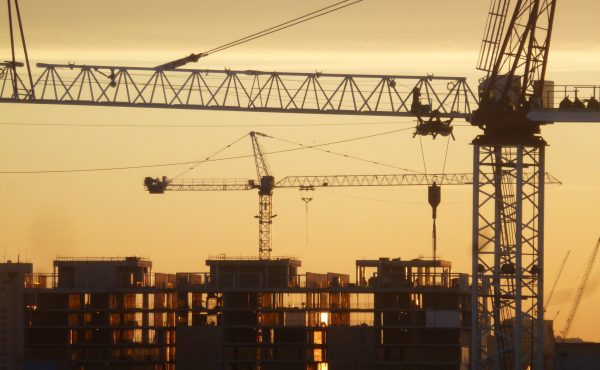Last night, I attended a discussion organized by the University of Toronto’s Cities Centre about municipal finance, with two people who know more about it than almost anyone: Enid Slack, a professor at the University of Toronto and one of the leading experts on municipal finance in Canada (because, as she joked, she is one of the only ones in Canada), and Shirley Hoy, Toronto’s City Manager from 2001 to 2008.
Given how much talk there has been about the city’s finances recently, I wasn’t sure if there would be much new material in the discussion, but there were several interesting issues and ideas that came up.
Hoy talked about the structural deficit that has been present in Toronto’s budget ever since amalgamation and provincial downloading, which was supposed to be revenue neutral but wasn’t, she said, because Toronto has more social housing than other municipalities. (A questioner pointed out that the deficit was exacerbated by three years without a property tax increase under Lastman). Slack also pointed out that there are several kinds of downloading — for example, when the province improved water standards after Walkerton but did not provide money to municipalities to make those improvements, or when the federal government encourages more immigration but does not provide sufficient services to help immigrants adapt, leaving the city and schools to take up the slack.
But Hoy also talked about how far the city progressed towards reducing that structural deficit between 2003 and 2010. Between 2003 and 2006, the City secured new sources of funding – the GST rebate, a portion of gas tax revenues, and the potential revenue in the City of Toronto Act. Between 2006 and 2010, the City instituted two new taxes allowed by the Act (Vehicle Registration and Land Transfer) — although these only accounted for around 2.2% of total revenues. It also secured an uploading agreement with the province, which is removing many costs from the City budget, but which will not be completed until 2018. The City also, during this period, removed garbage disposal from the operating budget, making it self-funding through fees. Hoy also pointed out something that is often forgotten, that the City also engaged in a significant cost control effort in Miller’s second term, reducing costs significantly in many areas (visible in Matt Elliott’s chart of six years of budget balancing).
So do we still have a structural deficit? The consensus seemed to be, yes. But the chaotic nature of the City’s operating budget process, in which it is impossible to tell until the last minute whether it will meet its legislative requirement to balance the operating budget, makes it hard to figure out the real state of Toronto’s budget (and makes it easy to manipulate politically). It also, as Richard Joy of the Toronto Board of Trade pointed out, obscures the fact that there is a serious deficit in capital investment in our city as well, which is not being addressed.
I asked if there is any way this chaotic operating budget process could be improved. Hoy said that, towards the end of her term, the City was looking into moving to a 3-year operating budget cycle, but that hasn’t happened. The capital budget has already moved to a 10-year cycle, which Hoy said created a considerable improvement. Another questioner suggested an independent budget officer, like the federal government’s Kevin Page, who would provide ongoing, impartial updates and analysis of the city’s fiscal position. This strikes me as an excellent idea, and probably even more necessary in the City than in the federal government, especially given the contradictory and changing numbers produced by City staff, the Mayor, and councillors. While these two measures wouldn’t solve the budget process, they would surely improve it.
Hoy also pointed out the way that, since amalgamation, basic municipal services — roads, parks, the arts, planning, bylaw enforcement — have been gradually degraded through endless cuts, both in response to the structural deficit and to the need to feed the budgetary beasts of the Police and the TTC. The recent KPMG study apparently found that 85% of municipal services were being delivered at their minimum standard or below it. Slack pointed out the danger of this gradual degradation — that Toronto thrives by competing for the best talent, who are looking not just for salaries but also for attractive lifestyles. This liveability has been one of Toronto’s strengths, but continued degradation of services could make us less competitive.
Taxation is also a concern, of course, and Slack introduced the concept of a “revenue hill” — that there is a point at which hiking taxes begins to reduce revenue because property values go down and people leave. But she said that Toronto’s residential taxes are not close to reaching the top of that hill yet (whereas its commercial and industrial rates are near the top of that hill). And an audience member suggested the idea of a “services hill” — the point at which basic municipal services become degraded enough that property values start to fall.
Since there does, after all, seem to be a revenue problem, there was some discussion of what other sources of revenue would be possible. Slack pointed out that Toronto only actually imposes three taxes — property, land transfer, and billboard — whereas most cities have many other taxes (Chicago has 29, apparently). Slack cautioned, however, that “nuisance taxes” that bring in small amounts of revenue (e.g. entertainment taxes) are annoying, don’t make much difference, and are probably not worth the political capital it would take to introduce them. She prefers something like a sales tax (e.g. 0.5% added to HST), which both grows with the economy and has the benefit of capturing money from out-of-towners who use the city. She said that, while it’s preferable to do it region-wide, it would still work if just the City of Toronto was able to impose it, as the difference in pricing would be marginal — there are plenty of cities where a municipal sales tax already works successfully that way.
Hoy proposed that the solution lay in two additional forms of uploading. Social housing should be uploaded, she said, because it was redistributive, and so was best paid for by the more flexible provincial budget. The TTC, she proposed, should be uploaded to Metrolinx, since transit is increasingly a regional service and cannot be adequately funded locally. If that doesn’t happen, she proposed that the TTC should divide itself into an operational unit, which would take care of good customer service, and a separate planning and capital programs unit, since the skills (and the funding) involved in that aspect are quite different.
Slack concluded by pointing out the need for Toronto, whose budget and population are greater than at least half of Canada’s provinces, to have more independent powers. “We’re a city of 2.5 million with a $13 billion budget. I think we’re grown up.”
This talk was the first of a seriesabout city issues, “Toronto in question,” being hosted by the Cities Centre.




6 comments
Terrific info, Dylan. Fight farce with facts!
The “revenue hills” that Dr. Slack reffered to is a term used to describe the capitalization of taxes into values where the incidence is borne by the property owner
. While I am very familiar and respect the work Dr. Slack has done in the area of municipal ffinance, I have to disagree with her that the Toronto’s commercial rates are near the top. They are are way over. In 2006 the Globe & Mail’s John Barber observed……..
“Between 1998 and 2000, a period when assessments were frozen, the Business Education Tax rate in Toronto fell about 10 per cent — equivalent to a 5-per-cent cut in overall business taxes. But when Ontario properties were revalued in 2001, it turned out that commercial assessments in Toronto had increased by about 40 per cent.
By comparison, commercial assessments in the rest of Ontario, without the benefit of steep BET cuts, only increased 14 per cent over the same time period.
Even if the Toronto tax cuts were responsible only for a fraction of the huge gain in property values, they were self-financing — just as supply-side theory predicts.
Over the same two-year period, Toronto gained an impressive 100,000 new jobs — the sharpest growth in employment since the mid-1980s. “
Also worth noting is a report titled “Are Ontario Cities at a Competitive Disadvantage Compared to U.S. Cities?”, by Dr. Enid Slack . Dr. Slack compiled some data regarding the costs associated with providing municipal services in Toronto. In the year 2000, it reports that the cost to provide Transportation (not public Transportation) , public safety, Sewage, Water Solid Waste, Parks and Rec, Admin, and Libraries at $1,553 per person in Toronto. Per household this would equal approx. $3,800. These are not programs downloaded on the city. These are traditional municipal services. On average the city received $2,200 (not incl. the education portion) in property taxes per household. This gap has grown since then. Saying that the city does not have the ability to raise propertty taxes on residents while every other city in the region has rates that generate far more revenue per household is patently false. The city lacks the will, not ability to address tthe issue.
Glen – for once, I am in general agreement with you. Toronto’s residential property taxes are disproportionately low compared to surrounding municipalities, for many reasons including 4 separate “tax freeze” years since amalgamation (3 under Lastman, 1 under Ford).
People sometimes point out that Toronto’s property values tend to be higher, which pulls property taxes up, but I’d really like to see a chart comparing absolute property taxes in comparable houses between Toronto and surrounding municipalities.
The city has moved water and solid waste management to self-funded rates separate from the property tax, which is a start.
While any freeze in rezidential property taxes is a bad idea when there is such a large discrepency between costs and revenues, you have to look at the spending and revenues. A tax freeze with a spending freeze is less harmful than a a 3% tax hike with a 5% increase in spending ( covered up by use of reserve funds).
The best source for comparison data is locatedd here….
csconramp.mah.gov.on.ca/fir/Welcome.htm
btw my previous points are no different than those you agree with here, you might even want to search the number of times I have refferenced Dr. Slack.
Aren’t parking fees also another tax paid for by people from inside and outside Toronto?